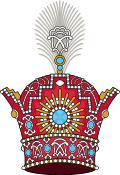| Part of a series on |
| Imperial, royal, noble, gentry and chivalric ranks in West, Central, South Asia and North Africa |
|---|
 |
Mostowfi ol-Mamalek (Persian: مستوفیالممالک) was One of the positions and titles of the Iranian court from the Ilkhanid period to the Qajar era.
Mostowfi ol-Mamalek was the leader of all Mostowfis. During the Safavid period, Mostowfi ol-Mamalek was in charge of the finances of the whole country and all the financial and tax affairs of the country and the dismissal and installation of the Mostowfis were done by him. Mostowfi ol-Mamalek was a powerful official during this period, and at the end of Sultan Husayn's term they had the right to participate in the Supreme State Council.
After his coronation, Nader Shah divided the position of Mostowfi ol-Mamalek among four people and appointed each of them to be in charge of the finances of a part of the country, but during Karim Khan Zand Reign, this position was again given to one person. At the beginning of the Qajar period, with the expansion of the Qajar bureaucracy, Mostowfi ol-Mamalek became the second prime minister after the Shah. One of the most influential political-noble families of Iran in the Qajar period named Mostowfian Ashtiani family took their name from this title.
List of Mostowfi ol-Mamaleks of Iran
Four Mostowfis in Afsharid period
- Mirza Mohamad Ali Mostowfi, Mostowfi of Fars
- Mirza Ali Asghar Mostowfi, Mostowfi of Khorasan
- Mirza Shafi Tabrizi, Mostowfi of Azarbaijan
- Mirza Bagher Khorasani, Mostowfi of Iraq
Zand period
- Mirza Mohamad Brojerdi, 1762–1781
- Mirza Mohamad Sadeq Mostowfi ol-Mamalek, 1781–1794
Qajar period
- Mirza Mohammad Zaki Ali Abadi, Mostowfi ol-Mamalek of Agha Mohammad Khan Qajar
- Mirza Yousof Ashrafi, Mostowfi ol-Mamalek in early Fath Ali Shah Qajar period
- Hajji Mohammad Hossein Isfahani, 1806–1813
- Abdullah Khan Amin al-Dawla, 1813–1823
- Mirza Mohammad Ali Ashtiani, 1823–1826
- Mirza Abul'Qasem Mostowfi ol-Mamalek, 1826-1830s
- Mirza Hassan Mostowfi ol-Mamalek Ashtiani, 1830s–1845
- Mirza Yusuf Ashtiani, 1845–1884
- Mirza Hasan Ashtiani Mostowfi ol-Mamalek, 1884–1925 (Abolish the title by Reza Shah)
References
- Esmaeili, Mojgan. "Administrative and executive structure in the Safavid period". Mazdak Nameh. 4: 40–46.
- Bahramzadeh, Mohammad. "The structure of the administrative-financial system of the Safavid period and its comparison with the Qajar period". Journal of Iranian Studies. 7 (7): 26–62.
- Imam Shoushtari, Mohammad Ali (1961). History of scales and cash in Islamic government. Tehran. p. 379.
{{cite book}}: CS1 maint: location missing publisher (link) - Khosrow Beigi, Houshang (October 1381). "Mostowfis and Mostowfi ol-Mamalek in Qajar period". Nameh Anjoman. 8 (2): 64–75.
- Shaʻbānī, ʻAlī (2018). The Thousand Families: Commentary on Leading Political Figures of Nineteenth Century Iran. Lang, Peter. ISBN 978-1-4331-4386-1.